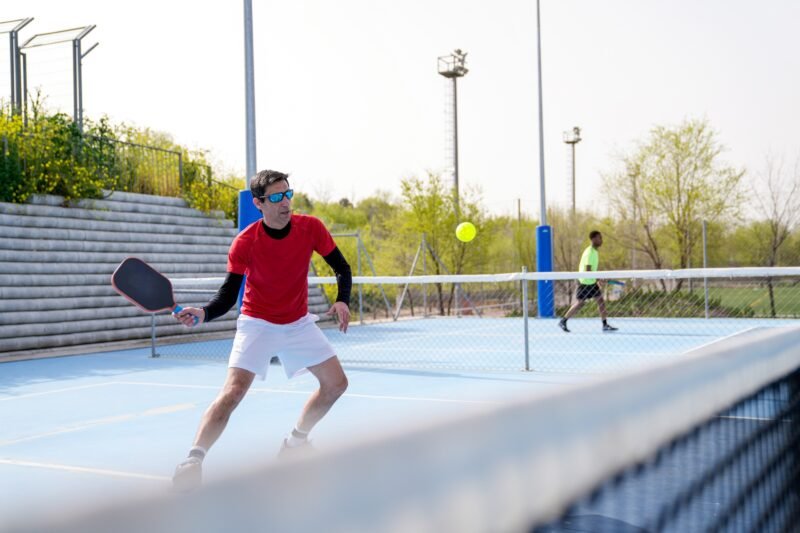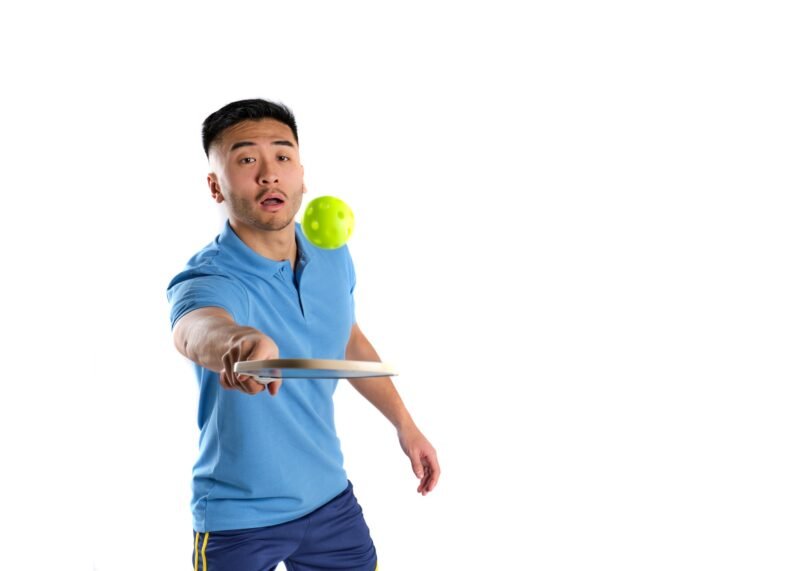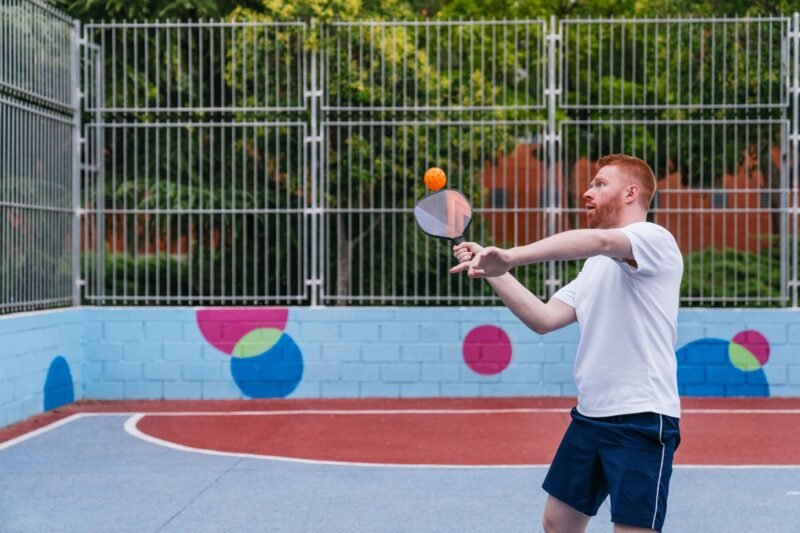How to Hit Spin Shots in Pickleball: Topspin, Slice, and Sidespin Tips
Prefer to listen? Tap play below!
Mastering Pickleball Spin Shots: Topspin, Slice, and Sidespin
Pickleball is a fast-growing sport that everyone from children to the elderly seems to have been caught playing. The more you play, the more you realize there is to the game. What starts off as a game of ‘keep it in play’ quickly turns into topspin, underspin, lobs, serves, smashes, and baseline drives. This article covers one of the most important aspects of the intermediate player’s game, the spin shot.
At its purest explanation, a spin shot involves spinning the ball in a certain rotation that makes the ball behave in strange ways off the bounce. This is a critical aspect of the game for offensive players that like to dictate the shot and the pace. When a ball is spun, it becomes naturally hard to read the shot that was just hit, due to its varied bounce and general flight of the ball.

A player focuses intensely as he prepares for a forehand shot in a pickleball game. Concept of concentration and skill.
Players are able to create unforced errors and set themselves up with their favorite shot:
- Topspin makes the ball dip quickly usually to the net or opponent’s feet.
- Slice gives a low bounce, usually requiring you to crouch down on the court to return.
- Sidespin shots moves to the left or right with an extremely varied bounce height.
There is a lot of information when to use a slice vs. topspin vs. sidespin. Remember to always have an athletic ‘ready’ position, and to practice moving your feet!
Understanding Pickleball Spin Shots
Pickleball spin shots are essential shots and concepts. Being able to spin the ball adds another dimension (both figuratively and literally) to the game that can psych out your opponent.
When you spin a ball, you are imparting a certain amount of diagonal or sometimes even horizontal rotation to the ball, so it doesn’t behave in the same parabolic way that a “flat” shot would.
Topspin gives the ball a rotation that propels it forward, causing the ball to drop dramatically after it goes over the net. The quick drop of the ball can make the opponent miss the return shot or pop up the ball for an easy hit after. On top of that, topspin can also push your opponent farther back and give your shots some more “muscle,” forcing them to return the ball from way behind the kitchen line.
The backspin, or “slice”, gives the ball a backward rotation that can make it either “float” or “skid”. Backspin can be used on a drop shot to make the ball “die” on the ground and make it essentially “unreturnable. Backspin makes the banger players move to the ball, which can expose the middle of the court for a put-away shot. Or, it can be used as a pace-changer if the opponent becomes too comfortable with your other shots.
“Spinning” the ball also disguises the placement. Players that aren’t used to spinning balls will judge the ball differently from how it’ll actually behave. The point is that spin can do more than just alter the flight of the ball, it also makes your opponent THINK, and oftentimes, this “thinking” will take them out of their game and cause errors.
All of these factors contribute to the rate of success during any rally, and this rate of success can ultimately affect your skill rating. Just as powerful, “quick” serves will subconsciously build a returner’s anxiety, “spinning out” the ball will do the same.
The Art of Pickleball Topspin
Topspin is a term that you will hear very often when it comes to pickleball. It’s one of the factors for the game that significantly impact how you control the ball and its trajectory. Just like backspin, topspin is another type of spin that can cause your opponent to experience a harder time trying to get the ball back to you. This type of shot can create a higher apex on the shot, resulting in a situation where the ball lands deeper in the opponents’ court and forces them to make a choice to play it in many cases. Typically, topspin ball produces a higher, less friendly bounce for opponents to handle, pushing your opponents backward as they have to respect your deep shot, as well as opening up the court later on to use. The approach for this technique should begin from the bottom and then hit the bottom on your way up, in a kind of shifting motion. So, when the ball is driven forward because of the angle of your paddle, it causes the ball to rotate forward in terms of its trajectory.

young asian man in blue sportswear hitting a pickleball ball on white background
Mastering the Pickleball Slice
The slice shot in pickleball is a special way of hitting the ball so that it curves and stays low after it bounces. You hit the ball with a slightly open paddle face and a particular ‘slicing’ motion that changes the spin of the ball. Let’s look at what that means and how to hit a pickleball slice.
What makes the slice shot interesting is how you can use it to disrupt the timing and rhythm of another player. Since you hit the ball with the paddle slightly open, it changes the trajectory of the ball.
You can use the slice to more easily change the direction that you hit the ball. For example, if the ball comes directly at you, with a slice (and a little practice) you can hit down the line, cross-court, or even down the middle to keep your opponent guessing.
What makes the slice interesting is that if you hit with heavy spin and an eastern one-handed backhand grip, you may still need to employ a bit of a slice action (especially those around the shoulder area or lower) to keep the ball from sailing long. Depending on the effect of the top / backspin, this “slice action” can change the angle of the shot, doing things like:
- Reduced bounce – Because of the underspin, a slice shot will usually bounce lower than a shot hit from the baseline with topspin. Depending on the speed of the serve, how the server angles and swings their paddle, it can cut through the air with less arc and land further.
- Other bounces – Similar to a lob, if we increase the degree of the upward angle and drive the ball deeper into the court, it’ll slow the ball down and land in the back with a higher bounce.
The different effects that the top/back spin and the slicing action has on the ball allow for variation. The more variation, the more you are keeping your opponent guessing as to what you are going to do next.
Exploring Pickleball Sidespin
In pickleball, you’ll see a lot of sidespin. This spin alters the trajectory and behavior of the ball, causing it to take unpredictable bounces that make it hard to return.

Redhead man playing pickleball on outdoor court, hitting the ball with paddle in a pickleball match
Sidespin can be one of your best shots. At all levels of the sport, there are different techniques that are used to generate sidespin. You’ll see sidespin comes up again and again when learning spin serves. But that’s not all, you can use sidespin in just about every scenario imaginable!
Learning sidespin is difficult. You need proper body mechanics and a correct grip, and you also need to learn different swing paths and different paddle angles. Finally, you’ll need to learn it well enough that you can hit it during a match.
Preparing for a shot can take a very long time. There’s a lot of muscle memory required!
In summary, a good pickleball player is going to know how to serve and return strokes with the best backspin, sidespin, and topspin that they possibly can on their forehand or backhand.
General Pickleball Tips for Spin Shots
Learning to play with spin will take some time and a lot of solid repetition. The ability to play with spin is one of the most underrated skills in pickleball. A well-developed spin game can add A LOT of control and difficulties for your opponents. However, this ability doesn’t come too naturally to many of us. All except the lucky few will need to spend a lot of time practicing to hit the ball right.
A few common drills that might help you practice are:
- The Topspin Drill: hit the ball using a low-to-high motion so that your paddle will brush the ball upward, creating a topspin. Practice hitting against a wall or with a friend with this drill. In this way, you can teach yourself to control the angle and direction of your paddle needed to hit a decent topspin.
- The Side Spin Drill: hit the ball using a side motion so that you create a side-spin. You can practice this by putting cones and trying to hit them with a side spin serve.
However, there are also common errors that we often see when beginners try to implement the spin into their games.
- Usually, beginners will do well for 1-2 shots, but then their paddle angle becomes too inconsistent. This will, of course, lead to poor results and no-spin shots. Remind yourself to have the thumb and index finger squeeze the paddle a tiny bit harder, and the plane of your paddle face will become more stable when contacting the ball.
- Strike the ball too early or too late. This will prevent you from maximizing the effects that your paddle may have on the spin; thus, creating a weaker spin than the one you wanted. Remind yourself to practice the timing on the ball machine, at the court, or with a friend. When you have mastered the right technique, always try to hit some during the warmup before a real match.
- Over rotation. This will lead to your whole body being off-centered, which again will prevent you from getting the rhythm of the motion. You should learn to prevent this mistake as early on as possible. Learning to hit a perfect topspin will obviously alleviate some of the problems, but generally, try to focus on footwork, early preparation of strokes, and taking the ball early. Mastering footwork is beneficial not only for spin but all pickleball aspects in general.
In the world of pickleball, your game can enjoy the benefits of learning to use spin on the ball. Whether it’s topspin, traditional slice, or sidespin, each can change the flight and bounce of the ball, things that create frustration for those having to return it.
Learning these shots will allow you to have more control over the shot you’re hitting and help to dictate the point in your favor.
Other Articles
Pickleball Tips for Playing with Kids
Pickleball Tips for Playing in Small Spaces
Pickleball Tips for Playing with a New Partner
Pickleball Tips for Playing in Tournaments
Pickleball Tips for Playing Against Aggressive Opponents
Pickleball Tips for Mixed Doubles Teams
Pickleball Tips for Left-Handed Players
Pickleball Paddle Materials Compared
Pickleball Tips for Playing Outdoors

